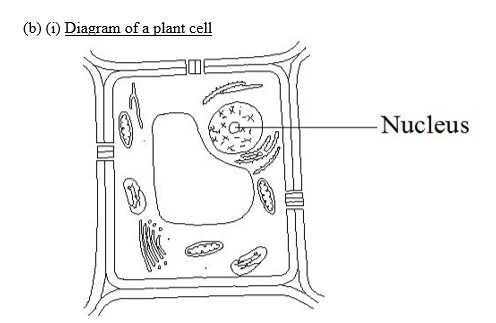QUESTION 1:
A sample of human blood was put in a test tube and allowed to spin in a centrifuge. The components of the blood sample were clearly separated.
(a) (i) What is a cell? [2 marks]
(ii) Name three scientists that are associated with the
discovery of the cell. [3 marks]
(b) (i) Make a diagram, 6 cm to 8 cm long of a plant cell
and label only the organelle responsible for cell
reproduction. [7 marks]
(ii) Name one blood cell in humans that does not have
the organelle labelled in 1(b)(i). [1 mark]
(iii) What is the biological implication of the cell named
in 1(b)(i). [1 mark]
(c) List six organelles found in a plant cell. [6 marks]
Observation
This question was very popular among candidates. Some of the candidates that answered this question had a range of good marks because they were able to define a cell and name the scientists associated the discovery of the cell. The candidates that performed poorly lost marks to poor spellings.
Some candidates were able to make good diagrams of a plant cell but some were unable to identify and label the organelle responsible for cell reproduction.
Many candidates could not name the blood cell in humans that does not possess a nucleus because they could not comprehend the question, neither could they give the implication of the cell not possessing the organelle for cell reproduction.
Many candidates were able to list the organelles found in a plant cell.
The expected answers are:
(a) (i) Cell
Is the basic/smallest structural/building block; and functional unit; of life.
(ii) Scientists that are associated with the discovery of the cell
- Robert Hooke;
- Matthias Schleiden;
- Theodor Schwann;
- Rudolf Virchow;
- Felix Dujardin.
Note: Spellings of complete names must be correct to score.

Title (TL) Diagram of plant cell
Quality (Q)
Size (Sz) (6cm to 8cm long)
Clarity of lines (CL) (lines not broken, not wooly)
Neatness of label (NL) (ruled guideline, horizontal label)
Details (D)
Rectangular/regular shaped cell (RS)
Central vacuole shown (CV)
Label (L)
Nucleus
Note: Spelling must be correct to score.
(ii) Blood cell in humans that does not possess nucleus
Red blood cell/erythrocyte
Note: Spelling must be correct to score.
(iii) Biological implication of the cell not possessing a nucleus
- It has a short life span;
- Unable to reproduce;
- Gives room for carriage of more oxygen.
(c) Organelles found in a plant cell
- Nucleus;
- Chloroplast;
- Rough Endoplasmic Reticulum;
- Smooth Endoplasmic Reticulum;
- Vacuole;
- Lysosome;
- Ribosome;
- Golgi body;
- Mitochondrion.
Note: Spellings must be correct to score.
